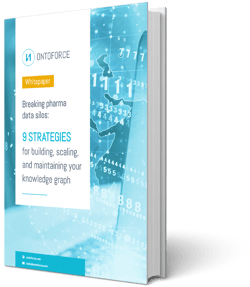.png)
BLOG
A knowledge graph is a powerful tool only if it is created and maintained properly – which can be challenging for teams or organizations who lack the expertise and/or the proper infrastructure to do so. Read on for insights into building and maintaining a reliable knowledge graph.
In the rapidly evolving pharmaceutical industry, the ability to quickly find and access data is not just an advantage but a necessity. This is where the use of a knowledge graph becomes invaluable. A knowledge graph is a powerful tool for organizing and analyzing data through the use of a network of interconnected entities and their relationships. For pharma companies, this means a more efficient way to handle vast amounts of data related to drugs, diseases, compounds, research findings, and more.
However, a knowledge graph is only a powerful tool if it is created and maintained properly – which can be challenging for teams or organizations who lack the expertise and/or the proper infrastructure to do so. Read on for insights into using, building, and maintaining a reliable knowledge graph.
The journey from drug discovery to market is long, costly, and complex. A knowledge graph helps pharma companies streamline this process by integrating disparate data sources, enabling researchers to find the data they need faster to accelerate processes along the development timeline. On top of this, by providing a holistic view of the data, knowledge graphs facilitate more informed decision-making that help drive success faster for organizations.
Knowledge graphs also allow users to uncover hidden connections and insights that can lead to advancements in various application areas, such as the discovery of new drug candidates or repurposing existing drugs for new therapeutic uses. In this way, knowledge graphs help pharma companies maximize the power and potential of their data.
Building a knowledge graph entails creating a structured representation of information, where entities and their interrelations are mapped in a way that mirrors real-world scenarios. This process starts with data collection where diverse sources such as multiple databases and text documents are mined for relevant information. The extracted data is then normalized and transformed into entities (people, places, organizations, etc.) and relationships (such as 'works at', 'located in') as part of a data integration process.
Data integration requires careful handling of various data formats and structures, ensuring that disparate data sets are harmonized and aligned within the graph's framework. Effective data integration is foundational to the knowledge graph's ability to provide comprehensive, accurate, and insightful information, making it a cornerstone of the graph's overall functionality and value. During the processes of data integration there are several factors to consider that can greatly impact the quality of a knowledge graph.
One such factor is data equivalency. Detecting and addressing equivalency in this context refers to the identification of different entities or concepts that essentially represent the same thing. For example, in a comprehensive knowledge graph with life sciences/healthcare data, it is essential that the graph recognizes that "Lou Gehrig's Disease," "Amyotrophic Lateral Sclerosis (ALS)," and "Motor Neuron Disease" all refer to the same neurodegenerative condition.

In our whitepaper “Breaking pharma data silos: 9 strategies for building, scaling, and maintaining your knowledge graph,” you can learn further about how to address equivalency along with other helpful strategies for building a robust knowledge graph.
The benefits of a knowledge graph are contingent on its accuracy and completeness. This is why proper maintenance is critical. Maintaining a knowledge graph involves a few different steps, such as regularly updating the graph with new data, verifying the accuracy of existing data, and refining the relationships between entities to reflect the latest scientific knowledge. Neglecting maintenance can lead to outdated or incorrect information, undermining the reliability of the insights derived from the knowledge graph.
Updating and refreshing existing data is especially an integral part of maintaining a knowledge graph. However, once there are many data sources being integrated into a graph, problems are bound to occur, especially when it comes to data updates. Downloading new data or data updates from various sources, especially public data sources, brings challenges thanks to variation in endpoint types (FTP, API, triplestore, etc.) and file formats (CSV, JSON, XML, TTL, etc.), which necessitates validation processes.
Additionally, as the pharmaceutical landscape evolves, the knowledge graph must also adapt. New diseases, drugs, and findings should be incorporated to keep the graph relevant and useful. This requires a concerted effort to update and grow the graph accordingly, however, not all graphs can scale gracefully. Ensuring that there is proper infrastructure in place to accommodate for scaling is essential.

In our whitepaper “Breaking pharma data silos: 9 strategies for building, scaling, and maintaining your knowledge graph,” we provide tangible strategies for effectively managing and scaling a knowledge graph.
For pharma companies, a knowledge graph is not just a tool but a strategic asset that can significantly enhance drug discovery and development while optimizing overall data management. It offers a way to navigate the complexities of the pharmaceutical industry more effectively by providing a comprehensive and interconnected view of relevant data. However, the utility of a knowledge graph is heavily dependent on its construction and maintenance. Properly maintaining a knowledge graph ensures that it remains a reliable and up-to-date resource that can support the critical decision-making processes in drug development and beyond. As such, investing in the creation and maintenance of a knowledge graph is an investment in the future of pharmaceutical innovation.
© 2025 ONTOFORCE All right reserved